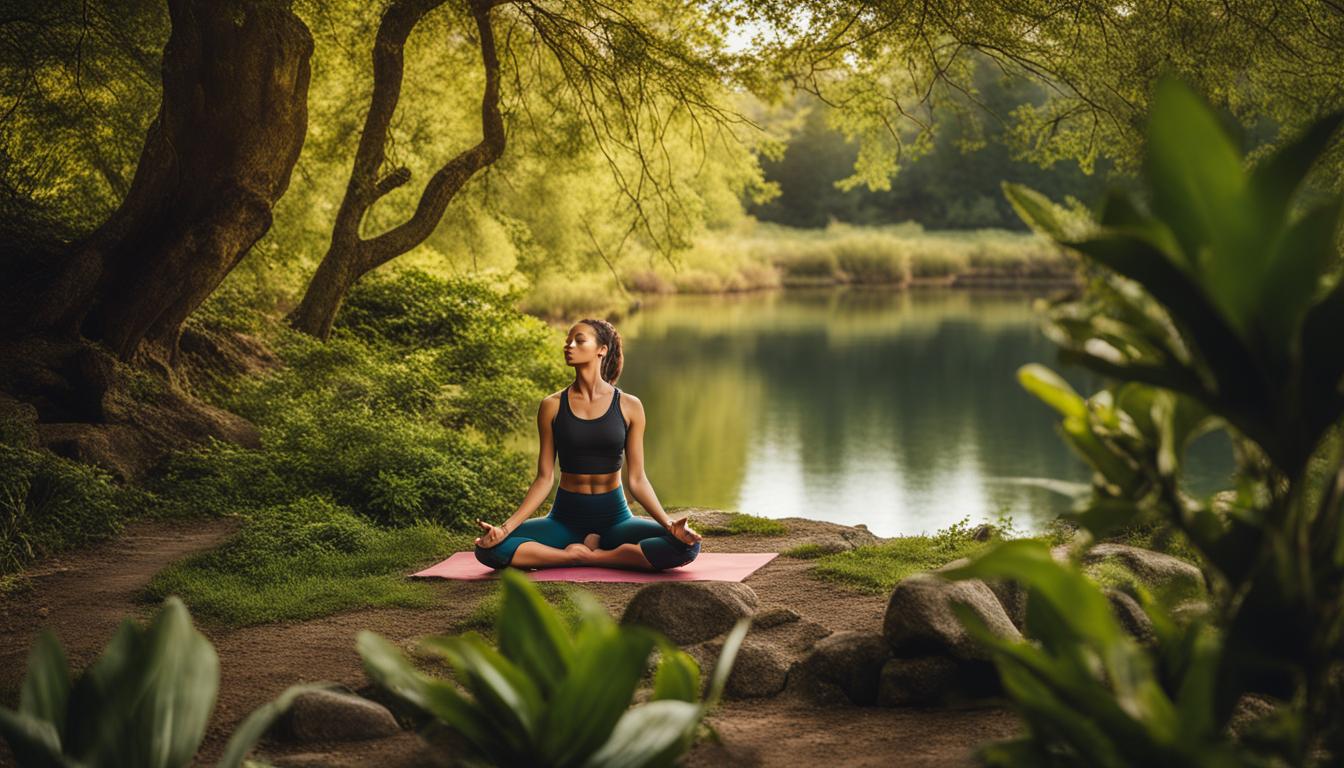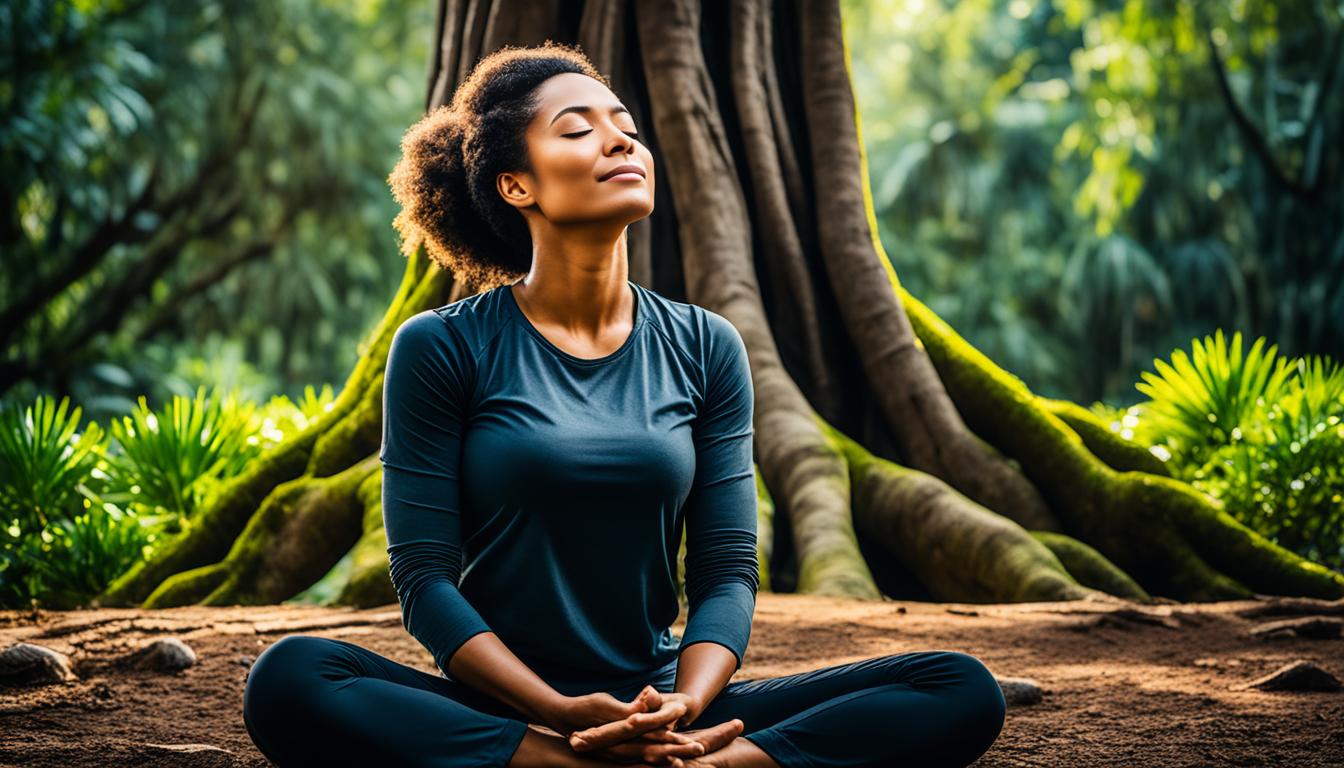Disclosure: This Post Contains Affiliate Links; We earn a commission on purchases.
Welcome to the world of meditation! Whether you’re a beginner or have some experience, establishing a consistent meditation routine is key to reaping the many benefits it offers. From calming the mind to reducing stress, meditation can enhance your overall well-being. In this article, we’ll explore effective strategies for building a meditation routine that sticks. Let’s dive in!
Key Takeaways:
- Consistency is crucial in building a successful meditation routine.
- By scheduling your meditation time, you prioritize and make it a non-negotiable part of your day.
- Incorporating meditation into another healthy habit helps create a natural connection.
- Practicing yoga or stretching before meditation helps release stress and prepare the mind.
- Eliminating distractions creates a peaceful environment for focused meditation.
Schedule Your Meditation Time
Consistency is key when it comes to building a meditation routine. And one effective way to ensure consistency is by scheduling your meditation time.
By setting up a specific time for meditation, whether it’s through a repeating alarm on your phone or a calendar reminder, you can greatly enhance consistency in your daily meditation practice.
When you schedule your meditation practice, you are more likely to prioritize it and make it a non-negotiable part of your daily routine. Just like you schedule important meetings or appointments, scheduling your meditation time sends a message to yourself that it’s a priority.
Identify a time of day that works best for you, whether it’s in the morning, during a lunch break, or in the evening before bed. Find a time when you can dedicate yourself fully to the practice without any distractions.
It’s important to treat your meditation time as sacred and non-negotiable. Honor that commitment to yourself and show up consistently at the scheduled time.
To help you stay on track, you can use a meditation app or a meditation timer that reminds you when it’s time to meditate. This way, you don’t have to constantly check the clock or worry about losing track of time during your practice.
Remember, by scheduling your meditation time, you are taking a proactive step towards creating a consistent daily meditation practice. So, find a time that works for you, set a reminder, and make meditation a regular part of your routine.
Tie Your Meditation Practice to Another Healthy Habit
Incorporating meditation into your daily life can be challenging, especially when trying to establish consistency. One effective strategy for making meditation a habit is to “stack” it with another healthy habit. By combining meditation with an activity you already do regularly, you create a natural connection that makes it easier to integrate meditation into your daily routine.
For example, you can try meditating before or after brushing your teeth. This habit stacking technique allows you to associate meditation with a specific daily task, making it more likely that you will remember and prioritize your practice.
Another option is to tie meditation to a physical activity like practicing yoga or stretching. By conducting these activities before your meditation session, you can prepare both your body and mind for a deeper meditation experience. Yoga and stretching help release tension and promote relaxation, setting the stage for a more focused and calming meditation practice.
Not only does habit stacking increase the likelihood of maintaining a consistent meditation practice, but it also helps you seamlessly incorporate mindfulness into your daily life. By associating meditation with an existing healthy habit, you create a powerful synergy that enhances the benefits of both activities.
To further illustrate how habit stacking can work, consider the following table:
| Existing Healthy Habit | Tied Meditation Practice |
|---|---|
| Drinking a Cup of Tea | Meditating for 5 minutes while the tea brews |
| Taking a Walk | Meditating for 10 minutes after returning from the walk |
| Journaling | Practicing a short mindfulness meditation before beginning journaling |
| Taking a Shower | Engaging in a brief meditation practice while the shower water relaxes you |
By tying your meditation practice to another healthy habit, you create a seamless flow in your daily routine. This makes it easier to prioritize and maintain your meditation practice, ultimately leading to a more consistent and fulfilling mindfulness journey.
Practice Yoga or Stretching Before You Meditate
Before you embark on your meditation journey, it can be beneficial to prepare your mind and body for the practice. One effective way to do this is by engaging in yoga or stretching exercises prior to your meditation session. Not only does this help release stress and tension from your body, but it also creates an optimal environment for experiencing inner quiet and stillness.
Yoga before meditation serves as a powerful tool to enhance your overall meditation experience. By incorporating gentle movements and deep stretches, you allow your body to release stored tension and improve flexibility, which can help promote a deeper sense of relaxation and calmness. Yoga also focuses on breath control, which can help bring awareness to the present moment, setting the stage for a more focused and productive meditation practice.
Whether you choose to follow a structured yoga routine or simply perform a few stretches, the key is to listen to your body and choose movements that feel comfortable and safe for you. Here are a few yoga poses and stretches that you can incorporate into your pre-meditation practice:
| Yoga Poses | Benefits |
|---|---|
| Child’s Pose (Balasana) | Relaxes the mind and calms the nervous system |
| Forward Fold (Uttanasana) | Relieves tension in the back and hamstrings |
| Seated Twist (Ardha Matsyendrasana) | Increases spinal mobility and aids digestion |
| Legs Up the Wall (Viparita Karani) | Relieves fatigue and promotes relaxation |
Remember, the goal of practicing yoga or stretching before meditation is to create a sense of ease in your body and mind. Allow yourself to fully immerse in the movements, paying attention to your breath and the sensations in your body. By incorporating yoga into your meditation routine, you can enhance your overall experience and cultivate a deeper sense of relaxation and mindfulness.
Eliminate Distractions
Creating a distraction-free environment is crucial for maintaining focus during meditation. Distractions can disrupt your practice and hinder the deep relaxation and mindfulness that meditation offers. Here are some effective strategies to help you create a peaceful environment for distraction-free meditation:
- Closing the door: Find a quiet and private space where you can shut out external noise and interruptions. Close the door to create a sense of solitude and tranquility.
- Turning off phone notifications: Silence or turn off notifications on your phone to prevent any incoming calls, messages, or alerts from interrupting your meditation session. This will allow you to fully immerse yourself in the present moment.
- Wearing headphones: If you’re meditating in a noisy environment or can’t completely eliminate external sounds, consider wearing noise-canceling headphones. Listening to soft instrumental music or guided meditation tracks can also help create a serene atmosphere.
- Setting a timer: Instead of constantly checking the time on your phone, use a meditation timer with a gentle chime or vibration to signal the end of your session. This will prevent you from getting distracted or worrying about how much time has passed.
By implementing these strategies, you can create a distraction-free space that allows you to fully immerse yourself in your meditation practice. Remember, the more you minimize external distractions, the deeper your meditation experience can be.
Testimonial:
“Eliminating distractions during my meditation practice has been a game-changer. By creating a peaceful environment, I’m able to let go of outside noise and truly focus on my breath and inner stillness. It has deepened my meditation experience and brought me a sense of calm and clarity.”
| Benefits of a Distraction-Free Environment: | How to Create a Distraction-Free Space: |
|---|---|
| 1. Enhanced focus and concentration during meditation. | 1. Find a quiet and private space. |
| 2. Deeper relaxation and stress relief. | 2. Close the door to shut out external noise. |
| 3. Increased mindfulness and self-awareness. | 3. Silence or turn off phone notifications. |
| 4. Improved ability to stay present and let go of distractions. | 4. Consider wearing noise-canceling headphones. |
| 5. Use a meditation timer with a gentle chime or vibration. |
Meditate in the Same Place at the Same Time Every Day (if possible)
Establishing a consistent meditation location is essential for anchoring your practice and creating a sense of ritual. Whether it’s a designated corner of your room, a serene outdoor spot, or a special chair, having a dedicated space sets the tone for your meditation journey.
When choosing a consistent meditation location, consider the following:
- Find a quiet and peaceful area where you won’t be easily disturbed.
- Make sure the space is comfortable and conducive to relaxation.
- Personalize your meditation area with meaningful objects like candles, crystals, or inspirational quotes.
In addition to a consistent location, practicing at the same time every day further strengthens the habit and integration of meditation into your daily routine.
“By meditating in the same place and at the same time, you create an anchor for your practice. It signals to your mind and body that it’s time to enter a state of mindfulness, allowing you to quickly transition into a meditative state.”
Having a consistent meditation location and time promotes discipline, focus, and a sense of commitment to your practice. It helps establish a routine, making it easier to prioritize meditation amidst the busyness of daily life.
Remember, meditation is a personal journey, and finding what works best for you is essential. Experiment with different meditation locations and practice times to discover what resonates with your mind, body, and spirit.
Benefits of Consistent Meditation Location and Time
| Benefits | Description |
|---|---|
| Deepens focus and concentration | When you consistently meditate in the same place, your mind becomes conditioned to enter a meditative state more easily, enhancing your ability to focus and concentrate. |
| Creates a sense of calm and relaxation | A designated meditation location helps you create a serene and peaceful environment, allowing for a deeper sense of calmness and relaxation during your practice. |
| Enhances the effectiveness of meditation | Through consistent practice in the same location, you establish a strong association between the space and the state of meditation, making it easier to enter a meditative state and experience its benefits. |
| Strengthens the habit of meditation | A specific meditation time and location make your practice a non-negotiable part of your routine, helping you stay committed and consistent in your meditation journey. |
Keep It Simple
It’s easy to feel overwhelmed by the multitude of meditation techniques available. However, keeping your practice simple can be a great starting point. By focusing on diaphragmatic breathing, also known as belly breathing, you can establish a foundation for your meditation routine.
Diaphragmatic breathing involves inhaling deeply through your nose, allowing your belly to expand, and exhaling slowly through your mouth, allowing your belly to contract. This technique helps activate the relaxation response, reduces stress, and promotes a sense of calm.
To practice diaphragmatic breathing, find a quiet and comfortable space. Sit or lie down in a relaxed position, placing one hand on your chest and the other on your belly. Take a deep breath in, feeling your belly rise as it fills with air. Exhale slowly, feeling your belly fall as you release the breath. Repeat this process for several minutes, focusing on the sensation of your breath and letting go of any thoughts or distractions.
Focusing on the Present Moment
In addition to diaphragmatic breathing, another simple meditation technique is focusing on the present moment. This involves bringing your attention to your senses and observing the sensations, sounds, and thoughts without judgment. You can do this by closing your eyes and directing your attention to the present moment, just as it is.
As thoughts arise, gently acknowledge them and let them go, returning your focus to the present. This practice cultivates mindfulness and helps train your mind to be fully present in the here and now.
“Simple meditation techniques like diaphragmatic breathing and focusing on the present moment can have profound effects on your well-being. By keeping your practice simple, you can experience the benefits of meditation without feeling overwhelmed.”

Remember, meditation is a journey, and it may take time to develop a consistent practice. Be patient with yourself and embrace the simplicity of these techniques. As you continue to meditate and incorporate these practices into your daily routine, you will find that meditation becomes easier and more enjoyable over time.
Be Patient and Don’t Give Up
When starting a meditation practice, it’s important to remember that results may not be immediate. Patience is key in allowing your mind and body to adapt to this new practice. While some may experience the benefits of meditation right away, others may require more time to see the positive effects. Don’t be discouraged if you don’t notice immediate changes in your mental or emotional well-being. Consistency is key in establishing a meditation routine that brings long-term benefits.
Sticking with your meditation routine is crucial in reaping the full benefits of this practice. It’s like planting a seed and nurturing it until it grows into a flourishing tree. Allow yourself at least three months of regular meditation before evaluating its impact on your life. During this time, make a commitment to meditate consistently, even on days when it feels challenging or when you don’t feel motivated.
Remember, meditation is a journey, and just like any journey, it has its ups and downs. There may be days when your mind feels scattered, and it’s difficult to find stillness. Other days, you may experience a deep sense of peace and clarity. Embrace both the challenging and blissful moments, knowing that each meditation session contributes to your overall growth and well-being.
To help you stay motivated and committed to your meditation routine, remind yourself of the benefits that can be attained through consistent practice. Whether it’s increased focus, reduced stress, better sleep, or heightened self-awareness, these positive changes accumulate over time.
“Patience is not simply the ability to wait – it’s how we behave while we’re waiting.”
– Joyce Meyer
Patience and perseverance are not only essential in meditation but also valuable life skills. By cultivating patience in your meditation practice, you can carry this quality into other aspects of your life, fostering resilience and tranquility.
| Benefits of Patience in Meditation | Benefits of Sticking with a Meditation Routine |
|---|---|
|
|
By having patience in your meditation journey and sticking with your daily practice, you open yourself up to a world of profound transformation and self-discovery. Celebrate every small step forward, knowing that each moment of stillness and mindfulness brings you closer to a more peaceful and fulfilled life.
Track Your Progress
When it comes to building a consistent meditation practice, tracking your progress can be a powerful tool to help you stay motivated and maintain momentum. Many people find that keeping a record of their meditation sessions provides a sense of accountability and serves as a visual reminder of their dedication to the practice.
There are various ways you can track your meditation progress. One simple method is to make a note on your calendar each time you meditate. Whether it’s a physical calendar hanging on your wall or a digital one on your device, marking the days you engage in meditation can give you a tangible representation of your commitment and growth.
Another option is to use a meditation app that allows you to track your sessions. These apps often include features that record the duration of your practice, provide insights into your meditation habits, and even offer guided sessions to help you deepen your practice. By utilizing such apps, you not only have a convenient way to track your progress but also gain access to valuable resources and support within the app community.
“Tracking my meditation progress has been a game-changer for me. Seeing the streaks of days I’ve meditated gives me a sense of accomplishment and motivates me to keep going. It’s become a daily ritual that I look forward to.”
– Rebecca, meditation practitioner
Remember, tracking your meditation progress is not about perfection or meeting specific goals. It’s about celebrating your commitment to the practice and recognizing the effort you put in each day. Whether you use a calendar, an app, or any other method, find what works best for you and embrace the process of tracking as a tool to maintain your meditation momentum.
![]()
Conclusion
Creating a personalized meditation routine is a journey that requires time and dedication. However, the benefits that come with a consistent meditation practice make it all worthwhile. By following the tips outlined in this article, such as scheduling your meditation time, incorporating it into other healthy habits, and tracking your progress, you can establish a routine that enhances focus, relaxation, and mindfulness in your daily life.
Consistency is key in reaping the full benefits of meditation. By committing to a regular practice, you allow yourself the opportunity to cultivate a deeper sense of self-awareness, reduce stress, and enhance overall well-being. Remember that every moment you spend in meditation is an investment in your mental and emotional health.
Take the time to find what works best for you and tailor your meditation routine to fit your lifestyle. Whether it’s finding a quiet place, using guided meditations, or simply focusing on your breath, the important thing is to remain committed and stay consistent. Embrace the journey, be patient with yourself, and enjoy the profound benefits that regular meditation can bring to your life.
Source Links
- https://happinessclinic.substack.com/p/how-to-cultivate-a-consistent-meditation
- https://siyli.org/consistent-meditation-practice/
- https://www.headspace.com/meditation/daily-meditation-habit
Ryan Conlon is a passionate advocate for mindfulness and meditation, dedicated to helping others discover the transformative power of these practices in their lives. As the founder of Daily Meditation, Ryan’s mission is to provide a sanctuary for individuals seeking peace, clarity, and well-being amidst the chaos of modern life. With a background in psychology and years of personal experience with meditation, Ryan brings a wealth of knowledge and insight to his work. Through Daily Meditation, he shares practical guidance, inspirational content, and expert resources to support others on their journey toward greater mindfulness, resilience, and inner peace.
Subscribe to Our Newsletter


















